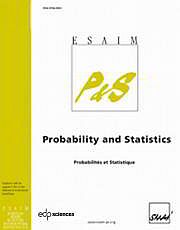Crossref Citations
This article has been cited by the following publications. This list is generated based on data provided by Crossref.
Pinelis, Iosif
2006.
On normal domination of (super)martingales.
Electronic Journal of Probability,
Vol. 11,
Issue. none,
Pinelis, Iosif
2007.
Exact inequalities for sums of asymmetric random variables, with applications.
Probability Theory and Related Fields,
Vol. 139,
Issue. 3-4,
p.
605.
Bentkus, V.
and
Juškevičius, T.
2008.
Bounds for tail probabilities of martingales using skewness and kurtosis.
Lithuanian Mathematical Journal,
Vol. 48,
Issue. 1,
p.
30.
Bentkus, V.
2008.
An extension of the Hoeffding inequality to unbounded random variables.
Lithuanian Mathematical Journal,
Vol. 48,
Issue. 2,
p.
137.
Lutz Dümbgen
Sara A. van de Geer
Mark C. Veraar
and
Jon A. Wellner
2010.
Nemirovski's Inequalities Revisited.
The American Mathematical Monthly,
Vol. 117,
Issue. 2,
p.
138.
From, Steven G.
2010.
Some Bounds on the Deviation Probability for Sums of Nonnegative Random Variables Using Upper Polynomials, Moment and Probability Generating Functions.
Missouri Journal of Mathematical Sciences,
Vol. 22,
Issue. 1,
Pinelis, Iosif
2012.
An asymptotically Gaussian bound on the Rademacher tails.
Electronic Journal of Probability,
Vol. 17,
Issue. none,
Pinelis, Iosif
2015.
On the supremum of the tails of normalized sums of independent Rademacher random variables.
Statistics & Probability Letters,
Vol. 99,
Issue. ,
p.
131.
Bentkus, Vidmantas Kastytis
and
Dzindzalieta, Dainius
2015.
A tight Gaussian bound for weighted sums of Rademacher random variables.
Bernoulli,
Vol. 21,
Issue. 2,
Pinelis, Iosif
2016.
On a multidimensional spherically invariant extension of the Rademacher–Gaussian comparison.
Electronic Communications in Probability,
Vol. 21,
Issue. none,
Chasapis, Giorgos
Liu, Ruoyuan
and
Tkocz, Tomasz
2021.
Rademacher–Gaussian tail comparison for complex coefficients and related problems.
Proceedings of the American Mathematical Society,
Vol. 150,
Issue. 3,
p.
1339.
Walther, Guenther
2022.
Tail bounds for empirically standardized sums.
Electronic Journal of Statistics,
Vol. 16,
Issue. 1,

